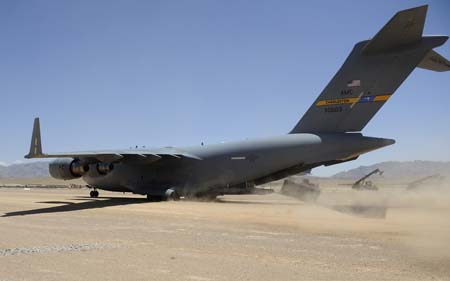The Pentagon is short-sighted  with its plan to end C-17 production at 205 aircraft, so says defense analyst Loren Thompson in a new Lexington Institute issue brief. Congress likely would not face an Obama Administration veto threat over the C-17, since the latest Administration policy simply reminded lawmakers that it wants to end C-17 production. Last fall, the Government Accountability Office cautioned the Pentagon against premature closing of the C-17 line, for one thing because the C-5 modernization issue was still up in the air and because the Pentagon had not yet completed a new mobility capabilities study—and it still hasn’t. Thompson takes an even more pragmatic view when he states that “the C-17 is the only plane that is well suited” to quickly hauling Army Strykers or MRAPs or the new similarly heavy infantry vehicle to a forward location, likely at an austere field. He explains that the majority of the 800 or so airlifters (C-130s, C-5s, and C-17s) and tankers and military-tapped commercial airlifters “disappear” when you “start analyzing real-world warfighting.” They either can’t make the range needed—most Army units will be stateside—or carry the weight or land just about anywhere. Thompson notes, too, that the continued heavier than expected use of C-17s for operations in Iraq and Afghanistan “probably” means we would use up “a mere 205 planes … long before a successor becomes available.”
with its plan to end C-17 production at 205 aircraft, so says defense analyst Loren Thompson in a new Lexington Institute issue brief. Congress likely would not face an Obama Administration veto threat over the C-17, since the latest Administration policy simply reminded lawmakers that it wants to end C-17 production. Last fall, the Government Accountability Office cautioned the Pentagon against premature closing of the C-17 line, for one thing because the C-5 modernization issue was still up in the air and because the Pentagon had not yet completed a new mobility capabilities study—and it still hasn’t. Thompson takes an even more pragmatic view when he states that “the C-17 is the only plane that is well suited” to quickly hauling Army Strykers or MRAPs or the new similarly heavy infantry vehicle to a forward location, likely at an austere field. He explains that the majority of the 800 or so airlifters (C-130s, C-5s, and C-17s) and tankers and military-tapped commercial airlifters “disappear” when you “start analyzing real-world warfighting.” They either can’t make the range needed—most Army units will be stateside—or carry the weight or land just about anywhere. Thompson notes, too, that the continued heavier than expected use of C-17s for operations in Iraq and Afghanistan “probably” means we would use up “a mere 205 planes … long before a successor becomes available.”
Top Lawmakers Want 15 Percent Pay Raise for Enlisted Troops
April 19, 2024
A new law introduced by Congress would raise the pay rate 15 percent for junior enlisted troops and seek improvements on a range of quality of life issues, such as pay and compensation, child care, housing, health care access, and military spouse employment.